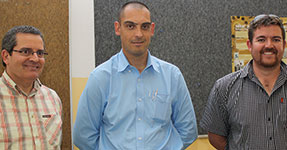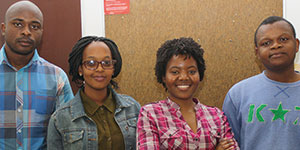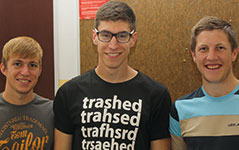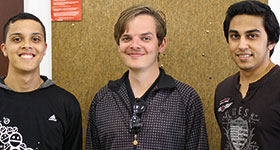
The 2015 Pneudrive Challenge mechatronics competition is well advanced. Technews editors, Kim Roberts and Steven Meyer spent a fascinating afternoon with the top three groups from Wits Mechanical Engineering Department, together with their lecturer, Professor Joao Nobre, to find out what’s involved from a student’s point of view. This year students were challenged to design a game changer for a food and beverage factory.

Their enthusiasm and commitment was catching. They are having lots of fun but all of them are struggling to juggle this challenge with their study load and are spending significant time on the project – up to two days a week. They are at different stages, but are starting to consider their business plans, which they are finding to be a complete eye-opener. What stands out is that each team has a very different way of coping with the division of roles based on each member’s strengths, but all are highly effective and their teamwork is outstanding.
At Wits the Pneudrive topics formed the basis of a first semester group project for third years. Students then had the option to continue with the challenge or choose another project. They had all been through a mechatronics course earlier in the year which they found very helpful.
Autonomous warehouse floor cleaner

Vuledzani Madala, Portia Sibambo, Tiisetso Ramolobe and Nkosinathi Shongwe are developing an autonomous warehouse robot floor cleaner. They got this idea after visiting a brewery in Gauteng and noticing that there was a problem with bottles and waste lying around on the floor. Portia explains, “A mechanical broom and mop extends to the floor, absorbs liquid and pushes solid waste into a storage bin. The trick is then to separate the liquid from the solid. For navigation we are considering a random path control algorithm but are still doing research on this.”
This group has a well defined division of roles. Vule designed the concept. Nkosinathi did the drawing and animation and put the concept together. Tiisetso helped with drawing, improved the design and carried out the research. Portia is the leader and focused on the design of the pneumatic system and was also involved in the creation of the documentation for the presentation. “It started with the idea. We all contributed different types of concepts. We produced a design and then created a machine in our heads and brought it to life through drawing by putting together everything that we have been taught,” she says. “We all give each other support and help each other to find a solution. Each member does research individually and we then meet and brainstorm before compiling the design.”
She explains that further selection of components will depend on the engineering calculations and system requirements. For example if a lot of power is needed then they will have to select the right motor. SEW-Eurodrive gave them products to choose from as it was difficult to identify the right ones from thousands in the catalogues, but they aren’t constrained, they can use any they want. As Portia says, “The competition is very intensive and we need to put in extra to reach expectations and exceed them. You get extra points if you actually build a model and we are looking at 3D printing for this.”
For the business case they will determine whether their robot is cost-effective compared to employing cleaners. They know that this concept can easily be applied more broadly and they’ll be suggesting other potential applications as well.
Green energy in a potato chip factory

Richard Grieves, Craig Daniel and Micha Dedekind are looking at waste reduction in the potato chip industry, specifically the peels and starch waste water. This is converted into methane by means of an anaerobic digester. “We had the idea of biodegrading the waste, then it occurred to us that this produces methane as well, which is a renewable resource. The components are the digester, the pumps and the control system,” explains Richard.
He adds that they don’t have a leader because for such a small team it’s easy to divide the work. Craig and Richard did the calculations for the pipe networks and Micha brought it all together in a CAD drawing while the other two gave him the dimensions. “It was a constant ongoing process and it saved a lot of time. When we compiled the project, Micha just sent me the files and it all fitted together,” he says.
The team had to learn how a reactor works and is moving into new areas such as pumping viscous fluids. “In the mechatronics course we did a whole lot on valves and measuring devices but the difficult part will be integrating them so they work together,” continues Craig.
Richard explains that the control system design was done with the whole system in mind. “We looked at which elements we needed to control, such as the pressure in the tanks. The pH control was the most difficult. We had to choose a pump that was big enough as there are lots of 90° turns and we had to calculate properly to optimise everything.”
They are now considering the hazard and storage regulations for methane, opting for a low pressure, double bladder gas storage arrangement at 13 kPa. They are also looking at explosion-proof equipment and instrumentation. Space is an issue and they are hoping to pay a visit to a chip factory to get input into how to solve this problem.
Looking at the business case the three will weigh up the overall benefit against the fact that the system is expensive to install. Potato waste has zero value while starch costs money to purify and is also an environmental hazard. “If we could get it back as an energy source we could get a return on investment,” Misha adds.
Depalletiser for improved productivity

Markus Janse van Rensburg, Mikhail Villet and Muhammed Mangera are developing a depalletising system for recycling empty bottles. These come in empty on a pallet and need to be unpacked, cleaned and refilled. A suction arm removes the tear sheet as the pallet is unloaded. Then a scissor-lift table raises the pallet level with the conveyor, which comprises an overhead rail with cylinders. The arm is connected to a compressor creating the vacuum. The three got this idea by looking at the end result of a production line. They considered palletisers and then thought “What about doing the opposite?” They also noticed that not much was being reported in this area and saw a gap.
Muhammed is in charge of the pallet systems, Mikhail does all the hydraulics and pneumatics and Markus designed the system to move the tear sheets. He explains that this is a flat group and team members communicate by WhatsApp to ask questions and send quick messages. “We also talk to each other all the time. We did the drawings together and now have to take the three parts and put them into one report,” he says.
When choosing the components they first did their calculations and then looked through catalogues. For example for the overhead crane they needed a small powerful motor. For the scissor lift tables they are considering SEW-Eurodrive’s special Variolution package. This was developed for the automotive industry, where there are a lot of repetitive moves.
The three are already thinking about their business case. Their target customers will be small to medium size businesses where space is at a premium and depalletising of bottles is done manually, so there will be savings in time and improved productivity and safety.
Not just a pretty machine
The Pneudrive has been a huge learning curve for these young people. As Portia says, “Varsity teaches us the theory, but this is very practical.” Tiisetso continues, “You see that an engineer who is skilled in all aspects of design is going to be sought after out in the world.” Vule adds that the project has helped them reconcile theory and practical and made the engineering design real, where previously they used assumptions taken out of textbooks. “This is a bridge between the academic and the real world,” he says. Misha concurs, saying that they are pulling in all aspects of what they have learnt. “This adds meat to the business course we did last semester. In a lot of our previous projects cost was not an issue, we only had to show that we could design.” Markus says, “We learnt what calculations and analysis can do, how to choose parts and actually make an idea work, and to get something you can actually use, not just a pretty machine.”
These are impressive young people, and seeing what SEW-Eurodrive and its co-sponsors have achieved through this innovative competition gives one hope for the future.
For more information contact Lindy Ndaba, SEW-Eurodrive, +27 (0)11 248 7000, lndaba@sew.co.za, www.sew.co.za
| Tel: | +27 11 248 7000 |
| Fax: | +27 11 248 7289 |
| Email: | jklut@sew.co.za |
| www: | www.sew-eurodrive.co.za |
| Articles: | More information and articles about SEW-EURODRIVE |
© Technews Publishing (Pty) Ltd | All Rights Reserved